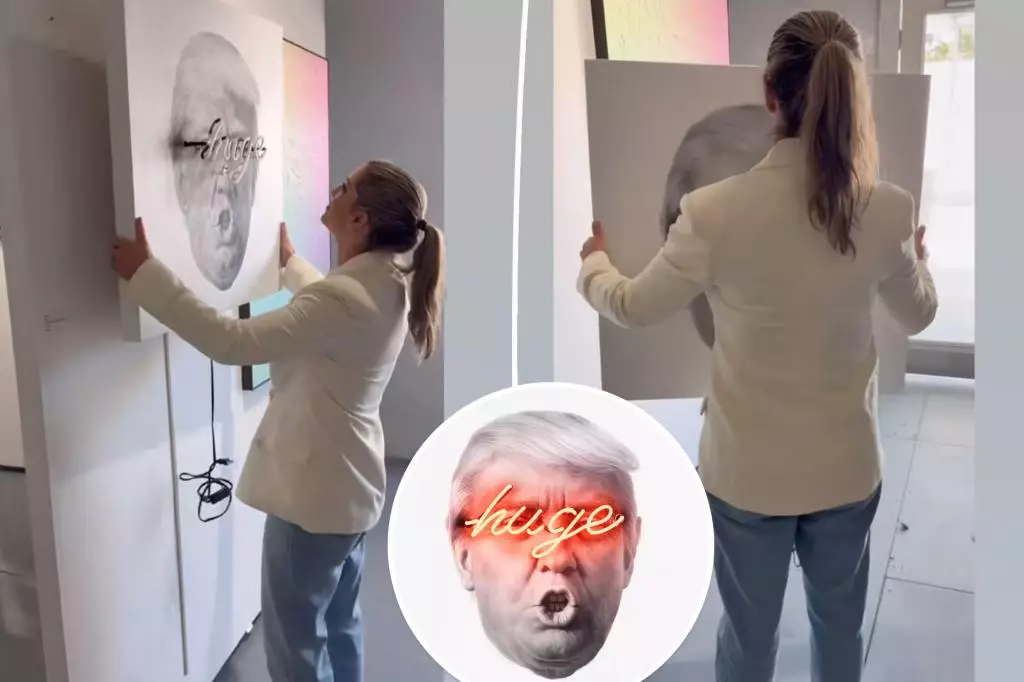The recent controversy surrounding an artwork featuring Donald Trump at the Scope Art Show in Miami raises critical questions about artistic freedom and the limits of censorship in the art world. The incident revolves around a photorealistic oil painting by artist Shyglo, which depicted the former president’s face beneath the illuminated word “huge.” This piece, although visually striking, became the center of a heated debate over whether it was appropriate for exhibition at a renowned art fair. The reaction from the gallery owner, Lindsay Kotler, sheds light on the complex interplay between artistic expression, political perceptions, and the institutional responsibilities of art fair organizers.
The painting in question, subtitled “Huge,” cleverly combines vibrant neon elements with a historic political figure. Shyglo is known for his inclusive artistic vision, having created works portraying famed icons from diverse backgrounds, including Marilyn Monroe and Notorious B.I.G. The apparent neutrality of the artwork—given its potential to be interpreted in various ways—further complicates the narrative. Critics assert that reducing the piece to a political statement limits its capacity to inspire dialogue and reflection, characteristics that art is meant to evoke. As Kotler remarked, the intent behind the painting was to foster conversations, rather than propagate divisive rhetoric.
Organizers’ Justification for Removal
Controversy erupted when gallery owner Lindsay Kotler was abruptly informed that the work had to be removed just hours before the official opening. Although fair organizers cited reasons of “suggestive” content, the initial lack of clarity surrounding the request raised eyebrows. Such actions point to an underlying tension that exists within exhibition spaces—a struggle between maintaining creative freedom and appeasing potential audience sensitivities. According to Kotler’s account, the reaction felt disproportionate to the artwork’s intent and thematic content, indicating a reluctance to engage with artistic pieces that might evoke strong feelings in the spectators.
Kotler’s strong reaction emphasizes the broader implications of this incident for artists and galleries alike. As she described, censorship stifles the critical role that art plays in society: a medium through which ideas, identities, and interpretations can be freely expressed and contested. If institutions prioritize perceived audience comfort over artistic integrity, the art world risks becoming stagnant, censoring diverse viewpoints rather than cultivating an environment for dialogue. Kotler’s assertion—that art should inspire thought and interpretation—speaks to a fundamental aspect of creativity that may be undermined in the politically charged atmosphere that pervades contemporary society.
This incident is not an isolated occurrence but part of a growing pattern of self-censorship and apprehension among artists, galleries, and curators. When political dynamics begin to dictate the acceptance of artistic expression, the very foundation of artistic exploration is called into question. The Scope Art Show’s decision to enforce this removal arguably indicates a broader trend within art exhibitions to avoid potential controversy, leading to an environment where artists may become hesitant to push boundaries or challenge societal norms for fear of backlash. Consequently, this calls into question whether art fairs can remain true to their mission of showcasing diverse and innovative works when the underlying fabric of political sensitivity wraps itself around the validity of artistic expression.
As the incident at the Scope Art Show illustrates, the friction between artistic freedom and institutional constraints continues to be a contentious issue. While fair organizers may have felt compelled to act for the sake of comfort and acceptance, it is crucial to reaffirm the role of art as a medium for exploration and provocation. Moving forward, there needs to be an open dialogue surrounding the implications of political movements on art censorship, inviting a diverse array of voices and interpretations to flourish within galleries and exhibitions. The art world must strive to embrace narratives that reflect the complexities of our society, urging a commitment to artistic integrity over political expediency.

